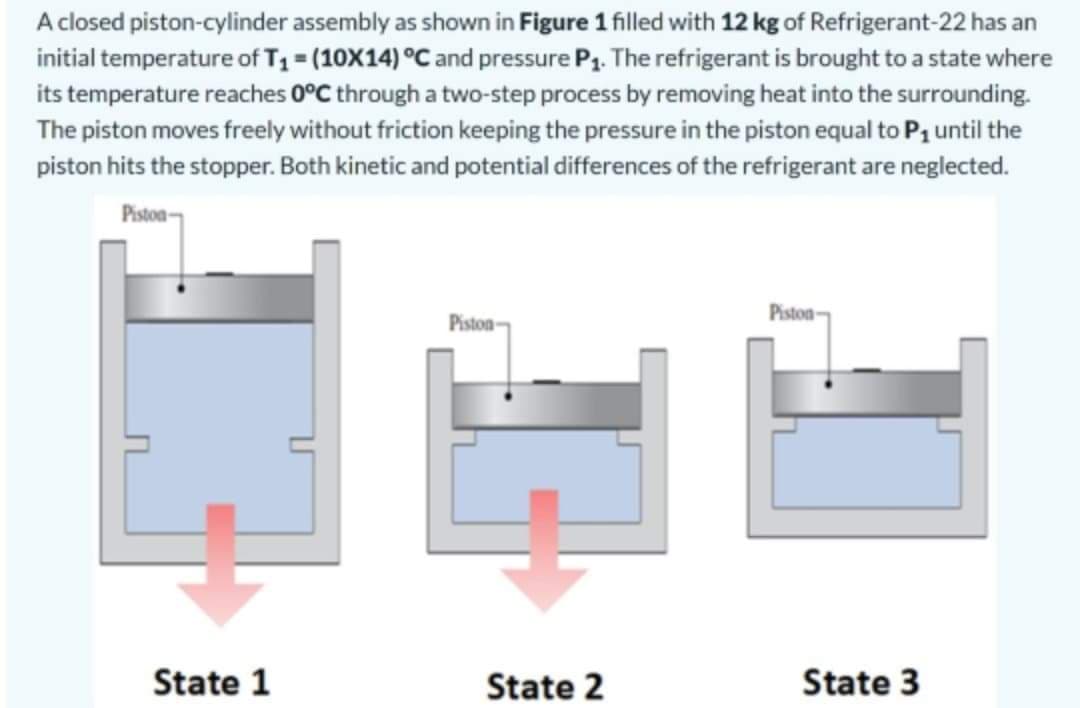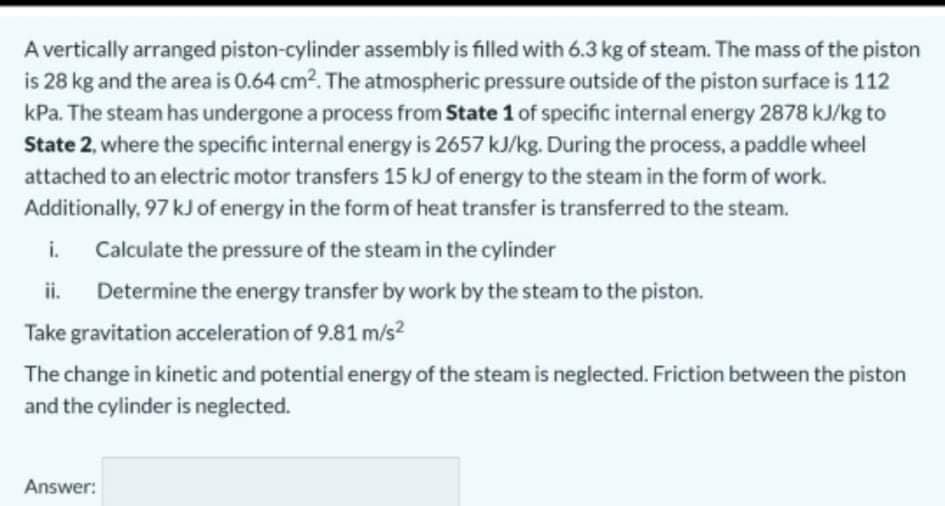A vertically arranged piston-cylinder assembly is filled with 6.3 kg of steam. The mass of the piston is 28 kg and the area is 0.64 cm2. The atmospheric pressure outside of the piston surface is 112 kPa. The steam has undergone a process from State 1 of specific internal energy 2878 kJ/kg to State 2, where the specific internal energy is 2657 kJ/kg. During the process, a paddle wheel attached to an electric motor transfers 15 kJ of energy to the steam in the form of work. Additionally, 97 kJ of energy in the form of heat transfer is transferred to the steam. i. Calculate the pressure of the steam in the cylinder ii. Determine the energy transfer by work by the steam to the piston. Take gravitation acceleration of 9.81 m/s? The change in kinetic and potential energy of the steam is neglected. Friction between the piston and the cylinder is neglected.
A vertically arranged piston-cylinder assembly is filled with 6.3 kg of steam. The mass of the piston is 28 kg and the area is 0.64 cm2. The atmospheric pressure outside of the piston surface is 112 kPa. The steam has undergone a process from State 1 of specific internal energy 2878 kJ/kg to State 2, where the specific internal energy is 2657 kJ/kg. During the process, a paddle wheel attached to an electric motor transfers 15 kJ of energy to the steam in the form of work. Additionally, 97 kJ of energy in the form of heat transfer is transferred to the steam. i. Calculate the pressure of the steam in the cylinder ii. Determine the energy transfer by work by the steam to the piston. Take gravitation acceleration of 9.81 m/s? The change in kinetic and potential energy of the steam is neglected. Friction between the piston and the cylinder is neglected.
Elements Of Electromagnetics
7th Edition
ISBN:9780190698614
Author:Sadiku, Matthew N. O.
Publisher:Sadiku, Matthew N. O.
ChapterMA: Math Assessment
Section: Chapter Questions
Problem 1.1MA
Related questions
Question

Transcribed Image Text:A closed piston-cylinder assembly as shown in Figure 1 filled with 12 kg of Refrigerant-22 has an
initial temperature of T1 = (10X14) °C and pressure P1. The refrigerant is brought to a state where
its temperature reaches 0°C through a two-step process by removing heat into the surrounding.
The piston moves freely without friction keeping the pressure in the piston equal to P1 until the
piston hits the stopper. Both kinetic and potential differences of the refrigerant are neglected.
Piston-
Piston-
Piston
State 1
State 2
State 3

Transcribed Image Text:A vertically arranged piston-cylinder assembly is filled with 6.3 kg of steam. The mass of the piston
is 28 kg and the area is 0.64 cm2. The atmospheric pressure outside of the piston surface is 112
kPa. The steam has undergone a process from State 1 of specific internal energy 2878 kJ/kg to
State 2, where the specific internal energy is 2657 kJ/kg. During the process, a paddle wheel
attached to an electric motor transfers 15 kJ of energy to the steam in the form of work.
Additionally, 97 kJ of energy in the form of heat transfer is transferred to the steam.
i.
Calculate the pressure of the steam in the cylinder
ii.
Determine the energy transfer by work by the steam to the piston.
Take gravitation acceleration of 9.81 m/s?
The change in kinetic and potential energy of the steam is neglected. Friction between the piston
and the cylinder is neglected.
Answer:
Expert Solution
This question has been solved!
Explore an expertly crafted, step-by-step solution for a thorough understanding of key concepts.
Step by step
Solved in 3 steps with 2 images

Knowledge Booster
Learn more about
Need a deep-dive on the concept behind this application? Look no further. Learn more about this topic, mechanical-engineering and related others by exploring similar questions and additional content below.Recommended textbooks for you

Elements Of Electromagnetics
Mechanical Engineering
ISBN:
9780190698614
Author:
Sadiku, Matthew N. O.
Publisher:
Oxford University Press

Mechanics of Materials (10th Edition)
Mechanical Engineering
ISBN:
9780134319650
Author:
Russell C. Hibbeler
Publisher:
PEARSON

Thermodynamics: An Engineering Approach
Mechanical Engineering
ISBN:
9781259822674
Author:
Yunus A. Cengel Dr., Michael A. Boles
Publisher:
McGraw-Hill Education

Elements Of Electromagnetics
Mechanical Engineering
ISBN:
9780190698614
Author:
Sadiku, Matthew N. O.
Publisher:
Oxford University Press

Mechanics of Materials (10th Edition)
Mechanical Engineering
ISBN:
9780134319650
Author:
Russell C. Hibbeler
Publisher:
PEARSON

Thermodynamics: An Engineering Approach
Mechanical Engineering
ISBN:
9781259822674
Author:
Yunus A. Cengel Dr., Michael A. Boles
Publisher:
McGraw-Hill Education

Control Systems Engineering
Mechanical Engineering
ISBN:
9781118170519
Author:
Norman S. Nise
Publisher:
WILEY

Mechanics of Materials (MindTap Course List)
Mechanical Engineering
ISBN:
9781337093347
Author:
Barry J. Goodno, James M. Gere
Publisher:
Cengage Learning

Engineering Mechanics: Statics
Mechanical Engineering
ISBN:
9781118807330
Author:
James L. Meriam, L. G. Kraige, J. N. Bolton
Publisher:
WILEY